The Wheelchair Guide
Your Wheelchair and Mobility Scooter Resource
Senior Mobility Scooters Explained
Sunday, February 28th, 2010
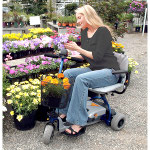 Wheelchairs are a powerful asset to those who are unable or have difficulty walking, but for seniors who are able to walk for short periods of time, the mobility scooter is often a better choice. Mobility scooters are similar to wheelchairs in functionality, but use a different design and typically cost less than an electric wheelchair.
Wheelchairs are a powerful asset to those who are unable or have difficulty walking, but for seniors who are able to walk for short periods of time, the mobility scooter is often a better choice. Mobility scooters are similar to wheelchairs in functionality, but use a different design and typically cost less than an electric wheelchair.
Mobility scooters, which are often called adult scooters, have a much longer base that an electric wheelchair does. The base, which is made out of molded plastic, has one set of wheels in the front and another in the back, although many are three wheeled, so only have one wheel in front. The user sits in a chair that is positioned more towards the rear of the scooter and a tiller, which is similar to a set of handlebars, extends from the front of the scooter and is used to control it.
The tiller usually allows the scooter to not only be turned, but also contain a key locking mechanism, speed controls, and is used to control any other accessories, such as horns and lighting. Many also come with a basket that is attached to the front of the scooter, although even those that do not can be fitted with an aftermarket basket.
Mobility scooters utilize rechargeable batteries, which mean unlike gasoline scooters, a mobility scooter can be used indoors and outdoors. The per-charge range varies by model, with most allowing for at least a 4 mile per-charge range.
Travel scooters, which are designed to be very lightweight, can be taken apart into several pieces, with the heaviest piece usually not weighing over 30 pounds. This way, the scooter can be taken apart and placed in the rear of a vehicle, without having to use a scooter carrier or lift. Of course, to reduce weight many of the comfort features are removed and travel scooters usually have a lower weight capacity and per charge range.
Heavy duty scooters, on the other hand, are almost the complete opposite of a travel scooter. They are designed with performance in mind and have a much higher weight capacity and can often travel over 20 miles on a single charge. With larger tires and higher ground clearance, as well as reinforced bumpers, heavyduty scooters are also have much better performance outdoors and across rugged terrain. However, since they are so much larger in size, it is necessary to use a vehicle scooter lift to transport them. Even though they, like most mobility scooters, can be disassembled into several pieces, the individual pieces are much heavier than those of travel scooters.
The Adult Scooter is often a lower cost alternative to the electric wheelchair. However, due to its design, a mobility scooter can not be driven directly up to a table or desk in the same way a wheelchair can. As a result, most people who use mobility scooters can walk for short periods of time. There are many wheelchair users though that invest in a heavy duty scooter for outdoor use, as they can be driven almost anywhere.
What Are Mobility Scooters?
Tuesday, February 9th, 2010
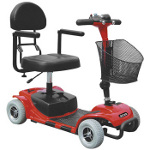 Moving around is often quite difficult for the elderly, especially among seniors who have arthritis. Since using a wheelchair can be quite strenuous, it is often not a good choice for seniors, especially those who intend to travel away from the home.
Moving around is often quite difficult for the elderly, especially among seniors who have arthritis. Since using a wheelchair can be quite strenuous, it is often not a good choice for seniors, especially those who intend to travel away from the home.
Mobility scooters provide a nice middle ground between an electric wheelchair and a regular wheelchair, while also often being better suited for outdoor use. This is because, in most cases, a mobility scooter is significantly less expensive than an electric wheelchair, so often the cost of a scooter vs a wheelchair is a big selling point.
The mobility scooter is not exactly a new medical device, with the first models being developed during the nineteen-sixties. However, it would not be until about twenty years later, during the nineteen-eighties, when their popularity really took off.
While the functionality they offer is similar to that of an electric wheelchair, adult scooters have a different design, with a longer base that has a set of handlebars in the front and a seat towards the rear. The electric scooter is controlled using the handlebars at the front, which is called a tiller, usually allows the scooter to not only be turned, but also the speed regulated and the control of any extras, such as lighting or horns.
Since the tiller is located in the front of the electric scooter, it can not be driven directly up to a table the same way you would an electric wheelchair. Instead, it is either necessary to exit the scooter and transfer to a chair or to drive the scooter up parallel to the table. To make it easier to transfer out of the scooter, the chair can be turned and some even come with automatic lifting chairs as well.
Different Types of Mobility Scooters
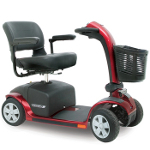 There are many different models of mobility scooters, but they can typically be classified as either a travel scooter, heavy duty scooter, or standard scooter.
There are many different models of mobility scooters, but they can typically be classified as either a travel scooter, heavy duty scooter, or standard scooter.
Heavy Duty Scooters are the most powerful and are designed to support more weight, as well as for outdoor use. As a result, they usually have reinforced bumpers, larger wheels, stronger suspension, and many other features. However, as they are much larger than other types of scooters, a heavy duty scooter usually requires scooter lift to transport the scooter away from home, as well as not being as well suited for tight quarter indoor use.
Travel Scooters are basically the direct opposite of a heavy duty scooter, with the focus being on making the scooter as lightweight as possible, so that it can be easily transported. This means they have fewer features and everything, from the tiller to the seat is designed to be as light as possible. A travel scooter can be taken apart easily and each individual piece is intended to be able to be easily lifted into a vehicle. Since a travel scooter is so light, they usually have the shortest per-charge range and a much lower weight capacity.
Standard scooters form the middle ground, trying to blend the right amount of features, with the overall weight of the device. As a result, they are not as easy to transport as a travel scooter, but have a larger range, more comfortable seating, and generally a number of comfort features. Usually they can be broken down into more manageable pieces, as can heavy duty scooters, but they are still much heavier than a travel scooter.
A Word About Wheels
Another way that mobility scooters are classified is by the number of wheels they have, specifically four wheel mobility scooters and three wheel mobility scooters. In the case of 4-Wheeled Scooters, there is a more even distribution of weight across the base of the scooter. This makes them more stable, as well as being better suited for larger weight capacities and outdoor use. For this reason, most heavy duty scooters are four wheeled.
Three wheeled scooters are not as stable, but they do have a smaller turning radius than four wheeled scooters. As a result, this makes them a better choice for indoor use. Also, since the front axle is smaller, they are also lighter, so many travel scooters use a three wheel design.
Mobility Scooter Buyers Guide and FAQ
Monday, January 18th, 2010
 Among the elderly, the mobility scooter provides one of the most valuable services for those who have difficulty walking. There are a number of different mobility scooter models available, as well as a number of different manufacturers, so it is sometimes overwhelming finding right mobility scooter, but when you know a little bit about them, it is not as difficult as it might seem.
Among the elderly, the mobility scooter provides one of the most valuable services for those who have difficulty walking. There are a number of different mobility scooter models available, as well as a number of different manufacturers, so it is sometimes overwhelming finding right mobility scooter, but when you know a little bit about them, it is not as difficult as it might seem.
Mobility scooters have been around for over forty years, but it was not until the eighties that they really became popular and more common place. Today, mobility scooters, which are sometimes called electric scooters or adult scooters, are very popular and provide a lower cost alternative to an electric wheelchair.
Below, you will find the answers to some frequently asked questions about these extremely useful senior mobility vehicles.
Table of Contents
- What Are Mobility Scooters?
- Where Can I Use My Mobility Scooter?
- What is the Difference Between Three Wheel vs Four Wheel Scooters?
- What Type of Speed and Battery Life Should I Expect?
- What Extra Features and Accessories Are Available?
- What Are Travel Scooters?
- What is a Heavy Duty Scooter?
- Who Are Some Popular Mobility Scooter Manufacturers?
What Are Mobility Scooters?
A mobility scooter is an electric vehicle that is used to carry a single occupant, typically both indoors and outdoors. They are similar to electric wheelchairs, except mobility scooters have a longer base, with the captain’s chair positioned more towards the rear of the scooter. A set of handlebars, called a tiller, is attached to the front of the scooter, which allows the scooter to be turned, as well as regulating speed, braking, and controlling the extra features, such as the horn and lights.
The main difference between a mobility scooter and an electric wheelchair is the addition of the tiller. Electric wheelchairs typically use a joystick control that is mounted to the side of the wheelchair’s arm rest, which allows the wheelchair to be driven directly up to a table or bench. Mobility scooters, on the other hand, are controlled by the tiller, which prevents it from being driven directly up to a table. Mobility scooters also usually cost a good deal less than electric wheelchairs.
Where Can I Use My Mobility Scooter?
Most mobility scooters are designed to be used indoors, as well as outdoors over tightly packed terrain. However, if you intend to use the scooter over loosely packed ground, such as dirt or sand, you may need to invest in a more durable mobility scooter. However, when driving over uneven terrain, even if it is tightly packed, it is important to be very careful in order to prevent the scooter from tipping over.
One thing to keep in mind is how much room you have indoors, as some mobility scooters are more maneuverable than others. The manufacturer will provide a turning radius, which describes the smallest space the scooter can turn it.
There are also environmental factors that can reduce the performance of the scooter. For example, driving a mobility scooter uphill will cause the battery to wear out quicker than when it is driven on flat terrain. Similarly, the weight of the rider also affect the per-charge range of the scooter, with a heavier rider reducing the range of the mobility scooter.
What is the Difference Between Three Wheel vs Four Wheel Scooters?
One way that mobility scooters are classified is by the number of wheels that they have, specifically, either three wheeled mobility scooters or four wheeled mobility scooters.
In general, a four wheeled mobility scooter will provide better stability and higher weight support, where a three wheeled mobility scooter will be more maneuverable. This is because the four wheeled scooter more evenly distributes the weight of the rider between the front and back of the scooter.
What Type of Speed and Battery Life Should I Expect?
Both the top speed and the per charge range, varies by model. However, most travel between 4-5mph and have a per charge range of between 8-10. There are, of course, exceptions to this, with some mobility scooters traveling over 10mph for distances of over twenty miles.
One thing to keep in mind when considering battery life, is that the amount you use the scooter will have a direct relation on how often you have to charge it and how long the battery lasts. For instance, someone that only uses their scooter once every few days probably would not need to charge the scooter everyday. On the other hand, someone who drives several miles each day on their scooter would probably have to charge it each night.
Environmental factors also play a part in battery life, with things like driving up hill or carrying extra weight causing the battery to wear down faster. Batteries do need to be replaced and depending on how much the scooter is used, this could mean replacing it each year or every few years.
What Extra Features and Accessories Are Available?
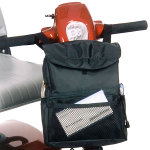 There are a number of extra features available for most scooters, which include things like cane holders, oxygen racks, and visibility flags. Often, some of these can be purchased cheaper at a bike store, as is the case with side mirrors and visibility flags, than you would be able to purchase them from a manufacturer. So, it is important to determine if it is a scooter specific accessory, which will only work with a specific model, or if it is an accessory that is generic, which will work with any type of scooter.
There are a number of extra features available for most scooters, which include things like cane holders, oxygen racks, and visibility flags. Often, some of these can be purchased cheaper at a bike store, as is the case with side mirrors and visibility flags, than you would be able to purchase them from a manufacturer. So, it is important to determine if it is a scooter specific accessory, which will only work with a specific model, or if it is an accessory that is generic, which will work with any type of scooter.
There are a number of bags that are also available, including armrest bags, under the seat bags, and back of the seat bags. Trays are also popular, which make it easier to eat, write, or work on a computer while using the scooter.
What Are Travel Scooters?
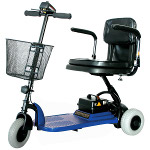 Travel scooters are lightweight mobility scooters that are designed so that they can be quickly and easily dissembled into several easy to manage pieces. Often, they use quick release snaps that can be activated with a single hand and the heaviest piece weighs only around 30 pounds.
Travel scooters are lightweight mobility scooters that are designed so that they can be quickly and easily dissembled into several easy to manage pieces. Often, they use quick release snaps that can be activated with a single hand and the heaviest piece weighs only around 30 pounds.
The advantage of a travel scooter is that it can be stored quickly and easily in a plane, car, or other vehicle, without having to use a scooter lift. Most travel scooters are three wheeled, as this helps reduce weight. However, they are also usually bare bones in regards to included features, which helps to reduce weight. Travel scooters are also not able to travel as far on a single charge, nor are they able to support as much weight or preform as well outdoors as other mobility scooters.
What is a Heavy Duty Scooter?
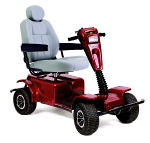 A Heavy Duty Scooter is one that is designed to support more weight and preform better outdoors than a regular mobility scooter. They typically are four wheeled, which provides the most stability and use air filled, pneumatic, tires, which improve suspension and off road performance. Heavy Duty Scooters are intended for outdoor use, so have larger wheels and a higher ground clearance, as well as having reinforced bumpers, extra large seats, and a number of other extra features.
A Heavy Duty Scooter is one that is designed to support more weight and preform better outdoors than a regular mobility scooter. They typically are four wheeled, which provides the most stability and use air filled, pneumatic, tires, which improve suspension and off road performance. Heavy Duty Scooters are intended for outdoor use, so have larger wheels and a higher ground clearance, as well as having reinforced bumpers, extra large seats, and a number of other extra features.
While Heavy Duty Mobility Scooters are well suited for outdoor use, have a very large range, and a much higher weight capacity than other scooters, they are much bigger than most other types of scooters. As a result, a heavy duty scooter might not work well inside of a smaller home and to transport it, a scooter lift would be needed.
Who Are Some Popular Mobility Scooter Manufacturers?
There are a number of mobility scooter manufacturers, but Pride Mobility and Golden Technologies are probably the most well known, with both companies having manufactured home medical equipment for over twenty years. While Pride Scooters and Golden Scooters are the most recognized, they also tend to cost more than other lesser known brands.
ShopRider is a company that offers a number of mobility scooters, which are typically priced lower than Golden Mobility Scooters and Pride Mobility Scooters.
Ultimately, if you decide not to go with one of the major brands, it is important to check for consumer reviews of the company and their scooters. Also, ensure that they provide a warranty for their scooter, which is similar to the length of a warranty on a name brand scooter. There are a number of very cheap scooters out there, but they will often have a very limited warranty, which means they should usually be avoided.
Saving Money on Mobility Scooter Accessories
Monday, November 30th, 2009
Mobility scooters are one of the most popular mobility vehicles used by seniors. They offer the convenience of an electric wheelchair, but usually cost less. This makes them an excellent choice for those who are able to walk for short periods of time, but with difficulty.
What Are Mobility Scooters?
The mobility scooter shares a number of similarities with electric wheelchairs, but the design is actually quite different. In an adult scooter, a chair sits towards the back of a base that is quite longer than most electric wheelchairs. A set of handlebars, called a tiller, extends from the front of the scooter, which allows the user to control the direction and speed of the electric scooter.
It is possible to get a three wheel or four wheel mobility scooter, with four wheel mobility scooters offering better stability and weight support. Three wheeled scooters, however, have better maneuverability and usually weigh less than 4 wheel scooters. For those who are going to be using the scooter primarily indoors, 3 wheeled scooters are often a good choice, as they work well in smaller spaces. For outdoor use or if a higher weight capacity is needed, 4 wheeled scooters are almost always the best choice.
Choosing the Right Mobility Scooter Accessory
There are actually a number of different mobility scooter accessories available, which can make the mobility vehicle more comfortable or more convenient. When considering accessories, it is important to differentiate between accessories that are specific to the actual model of scooter and generic accessories.
Scooter specific accessories, which are designed to only work with a specific brand or model of scooter, can be more expensive and are not carried by as many dealers. Some examples of scooter specific accessories would be an automatic lifting seat, which electronically raises and lowers the scooters seat, making transfers more convenient.
Generic Scooter Accessories, on the other hand, are often available much cheaper if you do a little shopping around and since they will work with many types of mobility scooters, it is not necessary to buy them from the same place you buy your scooter. Instead, it is often possible to save a great deal of money by doing some shopping around, where this is not really the case, with the price of most scooters being set by the manufacture.
For example, many mobility scooter dealers will sell visibility flags that can be attached to a scooter, making it more visible in crowds or to vehicles. A visibility flag would be considered a generic accessory, because it is not designed for a specific scooter and will instead work with most models. However, you can often get a much better deal if you goto your local bike shop and buy one of their flags. Scooter bags are much the same and you really can save a great deal of money by shopping around.
There are many types of scooter accessories, including oxygen holders, cane holders, bags, scooter trays, and baskets. By understanding the difference between scooter specific accessories and generic scooter accessories, you can save a great deal of money, because most dealers have a high markup on their accessories. These are the bread and butter, especially if you are getting your scooter for below MSRP.
Frugal TIP: Goto your local bike shop or sports store when looking for things like side-view mirrors, visibility flags, and bags for your scooter. Often, you will save money on these types of generic scooter accessories, as well as getting it right away instead of having to pay and wait for shipping.
Mobility Scooters for Seniors
Friday, May 22nd, 2009
 One of the most popular, if not the most popular, mobility aids for seniors is the mobility scooter. Mobility scooters were first developed during the 1960′s and share many similarities with the electric wheelchair.
One of the most popular, if not the most popular, mobility aids for seniors is the mobility scooter. Mobility scooters were first developed during the 1960′s and share many similarities with the electric wheelchair.
An electric motor propels the mobility scooter and it uses one or more batteries, much like a power chair. Often they also share a similar, if not identical captains chair, which includes the same types of features, such as a reclining back, electric lifting system, and swivel controls to make exiting the mobility vehicle much easier.
Like the other two kinds of mobility vehicles, mobility scooters also feature anti-tip casters to prevent the device from tipping over backwards.
However, the physical design of a mobility scooter is actually much different than that of a wheelchair, both electric and manual. This is because they have a much longer wheel base and the captains chair is mounted on the rear of the base.
Mobility Scooter Control Systems
Instead of an armrest mounted joystick, like is used on an electric wheelchair, a mobility scooter is controlled by a set of handlebars, which extends from the front of the scooters base. These handlebars, which are referred to as the tiller, can be adjusted to accommodate riders of different sizes. This allows the mobility scooter’s tiller to be brought closer or moved farther from the captains chair.
Depending on the model of scooter, the tiller might have a headlight, turning signals, battery meters, keyed entry, and troubleshooting gauges on it. Due to the location of the tiller, a mobility scooter can not be driven directly up to a table or desk.
Three Wheeled and Four Wheeled Mobility Scooters
There are a number of different types of mobility scooters available, with many different models available. There are also several ways that an electric mobility scooter can be classified.
One of the most common ways to classify a mobility scooter is by the number of wheels it has. 4 wheeled mobility scooters have two wheels in front and two wheels in the rear. This provides more stability, because as in the case of a rear wheel drive power chair, the weight of the occupant is spread out more evenly. This makes a 4 wheeled scooter more stable than a 3 wheeled scooter.
While a three wheeled mobility scooter might not be as stable as a four wheeled scooter, they are typically much more manuverable and have a turning radius that is considerably smaller than that of a four wheeled scooter. This makes a 3 wheeled scooter preferrable for indoor use. They are also typically lighter in weight.
Different Mobility Scooters for Different Uses
The other way that mobility scooters are classified is by their intended use. For example, there are travel scooters, heavy duty scooters, and traditional scooters.
 Travel scooters are designed to be as light weight as possible, so they can be taken on vacation or away from the home. They are also designed so that they can be easily disassembled, with all of the pieces being a manageable weight. Often the heaviest piece weighs less than 30 pounds, so most people are able to disassemble it and place it in the trunk of their car or rear seat of their vehicle.
Travel scooters are designed to be as light weight as possible, so they can be taken on vacation or away from the home. They are also designed so that they can be easily disassembled, with all of the pieces being a manageable weight. Often the heaviest piece weighs less than 30 pounds, so most people are able to disassemble it and place it in the trunk of their car or rear seat of their vehicle.
Most travel scooters are three wheeled, as this helps reduce the overall weight of the electric scooter. They also have fewer features, like a scaled back captains chair and no running lights, to further save weight.
Travel scooters do not have the same weight support or range that you could expect from other scooters, but for vacation they can be a great choice.
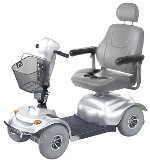 On the opposite side of the spectrum you have heavy duty scooters. A heavy duty mobility scooter is designed to be as rugged and durable as possible. They have the highest weight support, usually feature reinforced bumpers, larger tires, and are packed with features. They are designed, as the name implies, to be used over rough outdoor terrain. Typically, most are four wheeled as this provides the most stability, but there are a few three wheeled heavy duty scooters.
On the opposite side of the spectrum you have heavy duty scooters. A heavy duty mobility scooter is designed to be as rugged and durable as possible. They have the highest weight support, usually feature reinforced bumpers, larger tires, and are packed with features. They are designed, as the name implies, to be used over rough outdoor terrain. Typically, most are four wheeled as this provides the most stability, but there are a few three wheeled heavy duty scooters.
Heavy duty scooters also usually have a very high top speed, large per charge range, and can be a great deal of fun to drive.
While great for outdoor use, since a heavy duty scooter is typically much larger than other electric scooters, it can not be used in some indoor situations and has a much larger turning radius. It also weighs a great deal more so taking it apart and placing it in a vehicle might not be an option for most people. Heavy duty electric scooters are also the most expensive type of mobility scooter.
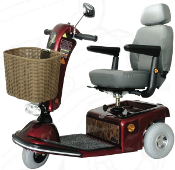 All other mobility scooters fall into the category of traditional scooter. These come in a variety of sizes and while they have many more features than a travel scooter, they have fewer than a heavy duty scooter. Typically though, they will have things like running lights. They come in either 3 wheeled or 4 wheeled designs.
All other mobility scooters fall into the category of traditional scooter. These come in a variety of sizes and while they have many more features than a travel scooter, they have fewer than a heavy duty scooter. Typically though, they will have things like running lights. They come in either 3 wheeled or 4 wheeled designs.
When compared to travel scooters, traditional scooters offer increased weight support, range, top speed, stability, and durability. Like heavy duty scooters, the weight of a traditional scooter often makes disassembling it not an option, because the lightest piece can often weigh well over 70 pounds.
Seniors and Mobility Scooters
Price wise the cost of a mobility scooter usually falls in the middle, between a manual wheelchair and electric wheelchair. They are easy to use and have a greet range, so can be a good choice for a senior who has difficulty walking.
Due to the location of the tiller, you are not able to drive a mobility scooter directly up to a table, which means that some mobility is required of the user in order to get the most benefit out of a mobility scooter.
For someone who can walk, but not for extended periods of time, a mobility scooter would be a good choice. However, for someone who can not walk, a mobility scooter might not be a good choice.
Electric Wheelchairs for Seniors
Thursday, May 21st, 2009
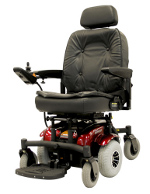 Electric wheelchairs, which are often also called power chairs, offer the advantage of a manual wheelchair, in that they are very maneuverable. However, unlike manual wheelchairs, power chairs are powered electronically, so they can typically be operated very easily, requiring very little physical activity of the senior.
Electric wheelchairs, which are often also called power chairs, offer the advantage of a manual wheelchair, in that they are very maneuverable. However, unlike manual wheelchairs, power chairs are powered electronically, so they can typically be operated very easily, requiring very little physical activity of the senior.
A simple joystick control scheme is most popular for controlling electric wheelchairs, which allows the senior to simply push the joystick. The joystick, which is attached to the arm of the power chair, then moves the wheelchair in the direction they wish to travel. Of course, there are a number of alternate wheelchair control systems available as well, including breath controlled systems and remote controlled systems, which are often used by caretakers.
A Brief Background on Electric Wheelchairs
The first electric wheelchairs, which were developed in the early 1950′s, were simply adapted E & J manual wheelchairs.
An electric motor was attached to the manual wheelchair, which was controlled using a simple joystick control scheme, although even during the 1950′s, researchers were already coming up with alternate control schemes. One popular method was to mount something similar to a joystick near the individuals head. They could then use their face to control the electric wheelchair.
The Modern Electric Wheelchair
Today, while some portable electric wheelchairs do use a traditional steel tubed folding wheelchair design, most look much different from a traditional manual wheelchair. Instead, an electric motor and battery is contained in the base of the wheelchair, usually covered by molded plastic.
A captains chair, which, depending on the cost of the power chair, often rivals that of most office chairs, both in comfort and durability, is mounted on the base of the wheelchair. The captains chair often reclines and swivels, to facilitate comfort and make transferring into and out of the wheelchair easier. Some even include an electric lifting system to raise and lower the chair.
While many power chairs share a similar design, one way they are often classified is by their wheels. A mid-wheel power chair features one set of large wheels in the middle of the base and one set of smaller wheels on the front and back of the base. The larger wheels are what does all of the work and are powered by the electric motor. The smaller set of wheels on either side of the drive wheels, provide extra support and stability.
The mid-wheel electric wheelchair offers the advantage of excellent maneuverability. It can turn in much smaller spaces. However, in some cases it might not offer the same stability as a rear-wheel drive wheelchair. This is because the center of balance for a mid-wheel wheelchair is in the middle of the power chairs base.
The other common type of electric power chair is the rear wheel drive wheelchair. These feature a set of rear wheels, which depending on the model might be slightly larger, and a set of front wheels, giving it four wheels in total. The rear wheels, are powered and what actually moves the power chair.
The rear wheel drive wheelchair does not offer the same maneuverability that a mid-wheel power chair does, but does offer increased stability. This is because the weight of the occupant is more evenly distributed across the base, making a wider center of balance.
As is the case with manual wheelchairs, power chairs, both mid-wheel and rear wheel drive models, include anti-tip casters to prevent the wheelchair from tipping over backwards.
Advantages of Electric Wheelchairs
One of the major advantages that an electric wheelchair offers is that it does not require much effort to use. Simply push the joystick and the power chair will move, with many offer very small turning radius and sensitive controls. The speed is often adjustable and some models can reach speeds of over 10 miles per hour.
The range of a power chair varies, but most can travel at least 5 miles without requring a recharge. Some can travel upwards of 20 or 30 miles per charge, but this often is dependent on the terrain and weight of the occupant. For example, if you decided to drive around the hills of San Fransisco, the battery would wear down much quicker than it would when used on flat land.
Along the same lines, if the rider weighed 300 pounds, the battery would wear down quicker than if they weighed 150 pounds. Often, an extra battery pack is purchased for those who use the power chair continuously, as this way when one battery pack wears down, it can be removed and charged, and the fresh battery pack used.
Electric Wheelchairs and Seniors
While the electric power chair can be an excellent device, especially for seniors, it is often cost prohibitive.
Of the three main mobility options, manual wheelchairs, electric wheelchairs, and mobility scooters, electric wheelchairs are by far the most expensive. When compared to mobility scooters, electric wheelchairs often also have a lower range, lower top speed, and are not as well suited to rough terrain. However, for indoor use, they are usually superior to scooters.
Manual Wheelchairs for Seniors
Monday, May 18th, 2009
For a senior, walking for extended periods of time can often be very difficult, which is often the result of injuries or in some cases diseases, such as arthritis. Finding a way to increase accessibility and mobility is very important and often a manual wheelchair will offer the least expensive option for a senior.
A Brief Introduction to Manual Wheelchairs
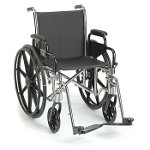 The wheelchair is probably the most well recognized and well known mobility aid, and its origins can be traced back many thousands of years. However, the modern wheelchair, with its steel tubed frame, two large wheels in back, and smaller wheels in front, is actually a fairly recent inventions. These manual wheelchairs, which can be found at virtually any hospital, store, or airport, are based off of the E & J wheelchair, which was first developed and refined during the 1920′s and 30′s.
The wheelchair is probably the most well recognized and well known mobility aid, and its origins can be traced back many thousands of years. However, the modern wheelchair, with its steel tubed frame, two large wheels in back, and smaller wheels in front, is actually a fairly recent inventions. These manual wheelchairs, which can be found at virtually any hospital, store, or airport, are based off of the E & J wheelchair, which was first developed and refined during the 1920′s and 30′s.
The E & J wheelchair, which features lightweight steel tubing and can be easily folded to make transportation easier, is still around today and serves as the basis for most manual wheelchairs. In fact, early electric wheelchairs also used the E & J design. Today there are many adaptations of the E & J wheelchair and many improvements have been made to increase durability, reduce weight, and improve comfort.
Seniors and Manual Wheelchairs
For a senior, a manual wheelchair is often one of the easiest ways to make getting from point a to point b easier. However, using a manual wheelchair requires a good deal of upper body strength, so as a result, most seniors who use manual wheelchairs rely on a family, friend, or caretaker member to push the wheelchair.
Due to their lightweight and lower cost, manual wheelchairs do make an excellent choice for traveling or going places, like an amusement park, where a lot of walking is required. This is of course, as long as there is someone available to operate the wheelchair.
In addition to the large rear wheels and smaller front wheels, manual wheelchairs also include anti-tip casters. Ant-tip casters extend from the rear of the wheelchair, usually at least six inches from the ground. In the event that the wheelchair is tipped backwards, the anti-tip casters make contact with the ground, keeping the wheelchair from completely tipping over.
Seniors and Transport Chairs
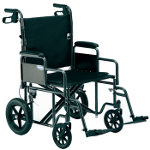 If the senior is not going to be using the wheelchair at all, transport wheelchair, which are also called transfer chairs, are available as well. A transfer chair is similar to a wheelchair, however it does not feature the large rear wheels, which make it possible for the wheelchair user to roll the chair independently, but are instead designed to make it easier for a caretaker or family member to roll the wheelchair. These are often a good choice because they are typically lighter and smaller, making them easier for a caretaker to use.
If the senior is not going to be using the wheelchair at all, transport wheelchair, which are also called transfer chairs, are available as well. A transfer chair is similar to a wheelchair, however it does not feature the large rear wheels, which make it possible for the wheelchair user to roll the chair independently, but are instead designed to make it easier for a caretaker or family member to roll the wheelchair. These are often a good choice because they are typically lighter and smaller, making them easier for a caretaker to use.
Pros and Cons of Manual Wheelchairs for Seniors
While manual wheelchairs or transfer chairs are often the easiest type of mobility aid to procure and are also often the most cost effective option, for a senior, they are often not the easiest type of mobility aid for a senior to use.
For use around the home, it could be a good choice, as they are very maneuverable and in such a small area, it would not require too much effort to use the chair. For long distances though, using a manual wheelchair could quickly become tiring for a senior, so manual wheelchairs might not provide the best choice for a senior who lives independently.